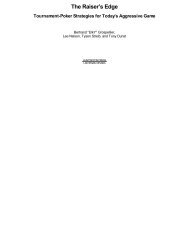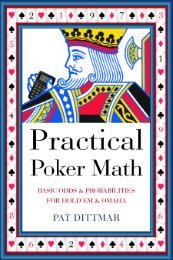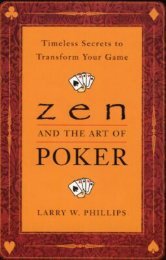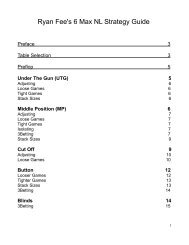Create successful ePaper yourself
Turn your PDF publications into a flip-book with our unique Google optimized e-Paper software.
52<br />
pretty simple, right? But, of course, we’re not going to be able<br />
to use this software when we’re playing. So, let’s learn how to<br />
get this percentage quickly when playing.<br />
Remember we defined an out as a card that can come on a future<br />
street(s) that can give you the best hand. We learned how to<br />
count outs. Counting outs gives us an easy way to estimate<br />
equity. There’s a rule call the 4/2 rule. Here’s how it goes. If<br />
you are on the flop and going to see both the turn and the river<br />
(like if you get all the money in on the flop), you can multiply<br />
your outs by four for an estimate of your equity. If you are on<br />
the turn, you can multiply your outs by two for an estimate of<br />
your equity.<br />
So, in our example hand, we have a flush draw. This is nine<br />
outs. We’re on the flop, so we can multiply our outs by 4 to<br />
come up with 36%. As we saw in <strong>Poker</strong>stove, this is the actual<br />
equity. <strong>That</strong>’s pretty simple, right? Let’s say the turn would<br />
come the K♥. Now we’re on the turn, and we still have nine<br />
outs. However, since we’re on the turn, we would now multiply<br />
our outs by two. This would be 18%. Let’s see how close we<br />
are. We’ll put K♥ on the turn and evaluate the equity again.









